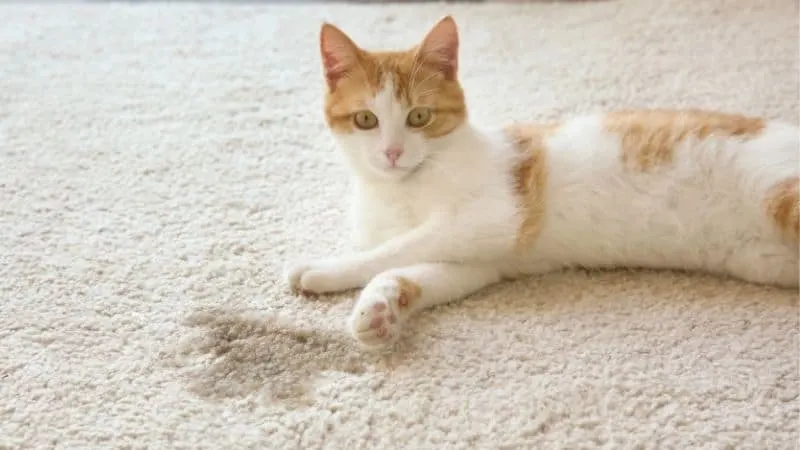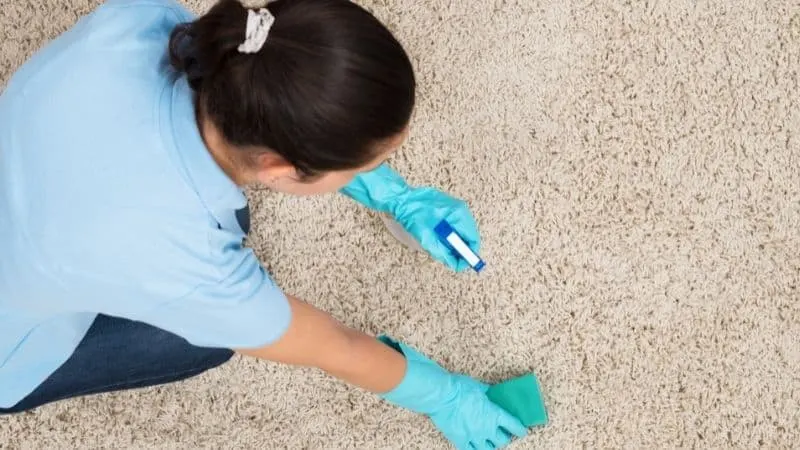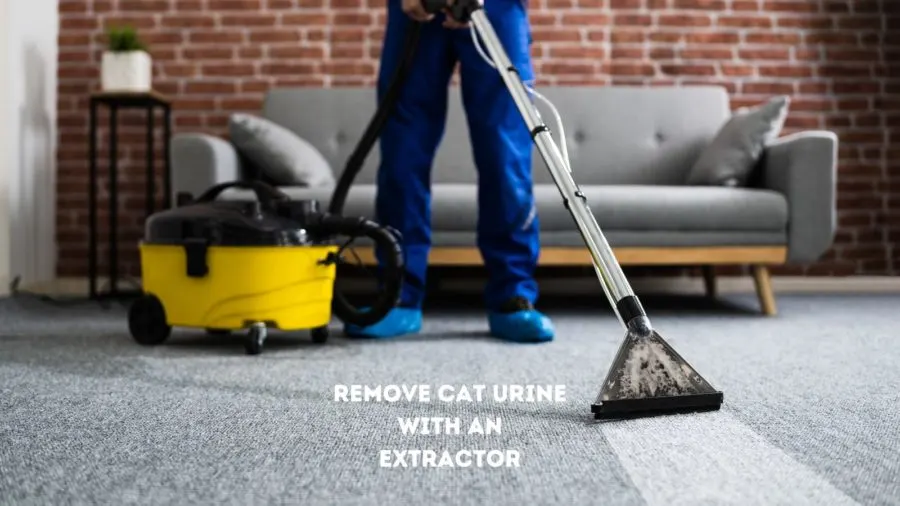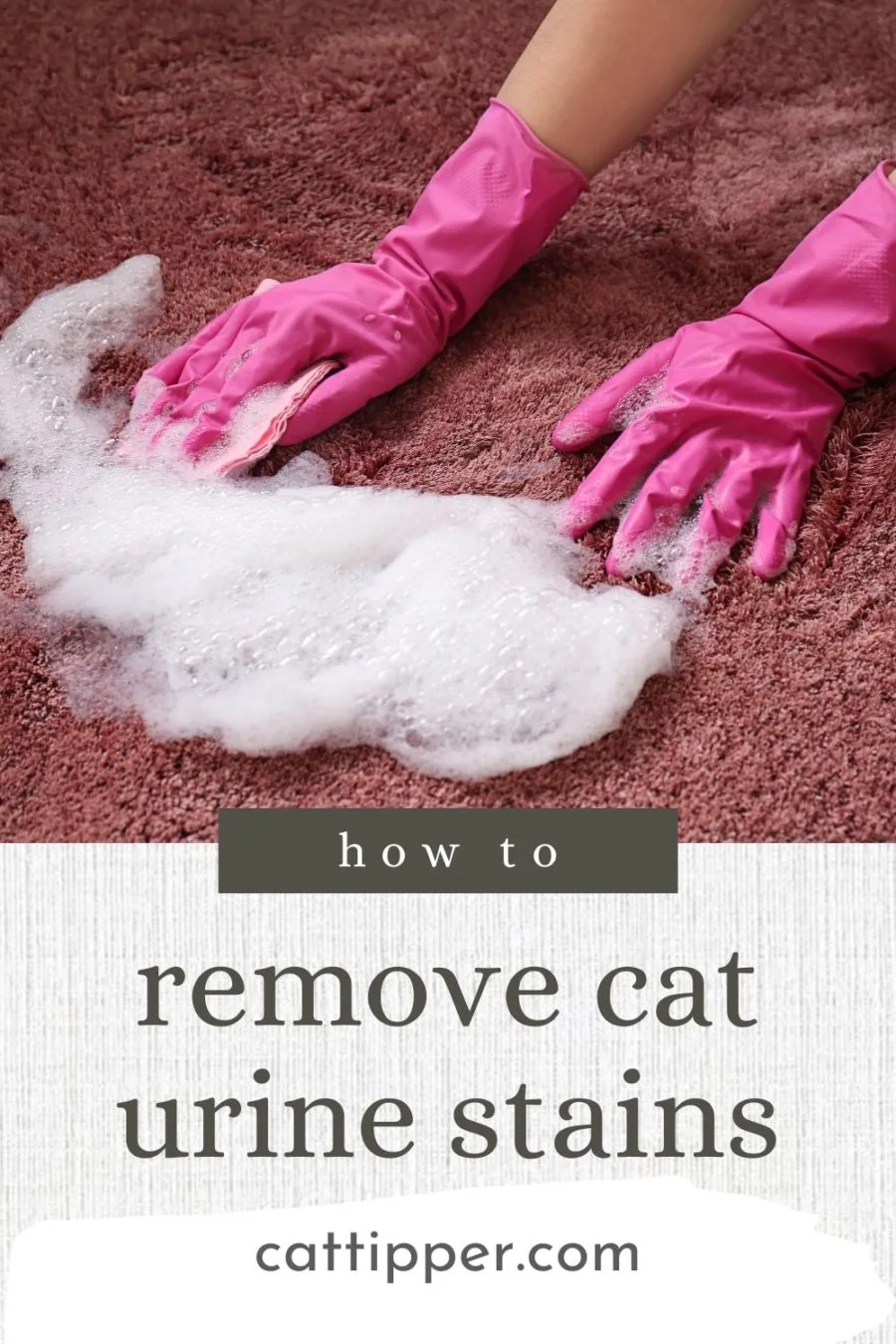Let’s face it: even with the best housetraining, accidents happen. From kittens who aren’t quite sure where the box is to cats who overshoot the litterbox to seniors whose bladders aren’t all they used to be, cat urine is just a fact of life in pet households–and so is removing cat pee and cat pee stains from carpet, laminate and wood flooring and even outdoor patios.
A quick look around any home or pet supply store and you’ll see that there’s no shortage of products to help clean and deodorize those pet urine stains. Sometimes, though, the simplest solutions can be the best!

If You Find a Fresh Cat Pee Stain
If you find fresh cat pee, the first step is to clean and blot as much of the stain as possible. Don’t rub it into the carpet or upholstery but, instead, blot with a clean rag or paper towel.
After blotting, step two is to try to remove even more of the stain that your rag cannot reach. Club soda, poured on the stain itself, can help bubble up more urine hiding in the rug pad.
Blot up the solution (again, taking care not to rub it into the carpet but to just gently blot).
Next, place a clean, white towel (so you don’t transfer any dyes from the towel to the carpet or upholstery) on the stain and weigh it down with a brick. Allow it to wick up as much of the stain as it can overnight.
How to Remove the Scent of Cat Pee

While the stain may be gone to our noses, it no doubt remains to our pet’s super strong olfactory senses—so that’s where the next step comes in. Enzyme cleaners are specially made products designed to destroy rather than mask organic stains. These eat up and neutralize cause of the odor; most have little or no scent.
If you don’t have an enzyme cleaner at hand, you’ll find some good substitutes in your cupboard. Don’t pick the ammonia (urine contains ammonia so you’ll just make it worse).
Instead, reach for white vinegar. Add about ¼ cup of white vinegar to a quart of water. Pour the vinegar and water solution on the stain, blot, and top with a white towel overnight.
Table salt can also help absorb fresh urine and remove some of its scent. (WARNING: Be careful to keep the salt out of reach of your pets. Dogs especially will try to eat salt and can suffer from salt toxicity.)
Baking soda is another great household product for removing that urine scent.
Still smelling it? Rub the area with a dryer sheet.
How to Remove Old Cat Urine Stains
We all know what it’s like to smell the scent of pet urine—but what if we can’t track it down? Dried urine is more difficult to find than fresh but a black light will make the task easy.
An inexpensive black light flashlight will cause urine stains to glow in the dark. (If, like us, you have to worry about scorpions in your house, they’ll also glow under the blacklight!
Once you’ve identified the source of the smell, treat it like a fresh urine stain by trying to flood the stained area with a vinegar and water solution then treating it with an enzyme cleaner.
If you can’t eliminate the odor with simple tools, it may be time to break out more serious products like Spot Shot (see our review).
Using an Extractor to Remove Cat Urine Stains from Carpet

You can use an extractor to remove both fresh AND old cat pee from carpets.
An extractor (I have a SpotBot Pet from Bissell) sprays water and product on the stain, scrubs it with a brush and then extracts the liquid from the carpet.
OdorKlenz Pet Urine Eliminator is specially formulated for pet households and can be used with extraction equipment (which is the preferred method) or a vacuum.
With the extractor, I first extracted water from the pre-cleaned area until it was just slightly damp then I poured OdorKlenz (shake first) on the already soaked and prepared stained area, spread it deep into the carpet by using my fingers (you can also use a comb) to get it down into the fibers then place a towel over the treated area and apply pressure to soak up extra moisture.
Leave the treated area alone for 15 minutes to let OdorKlenz do its thing then use clean water to wet extract the treated area, adding clean water and repeating this step two or three times until all visible residue is gone.
Wood, Stone and Tile Flooring
Cork Flooring
To remove cat pee from a cork floor, first blot the stain with a clean rag dipped (then wrung out) in a detergent solution of a ½ teaspoon of dishwashing liquid in two cups of room temperature water.
Next, blot with by a bleach solution of ½ a cup of bleach in a gallon of water; dip a cloth in the bleach solution, wring out the excess and gently blot the stain.
Cork is naturally antimicrobial so you won’t need to worry about the smell of pet urine as much as you would with other flooring. Hooray!
Linoleum and Vinyl Flooring
It’s fairly easy to clean cat pee from linoleum and vinyl flooring!
As with all surfaces, first blot up all urine you can.
Next blot the stain with an all-purpose cleaner then wipe.
Is the smell lingering? HowToCleanStuff recommends scrubbing the stain with a mixture of a cup of vinegar, two teaspoons of dishwashing soap (without bleach) and a gallon of water.
How to clean plastic laminate flooring
Laminate flooring is fairly stain resistant–but that doesn’t mean that stains and even damage aren’t possible due to pet urine.
It’s extremely important to mop up pet urine ASAP before it has a chance to get down into underlayment.
How to clean cat pee from tile and stone floors
Whether you are cleaning from limestone, marble, slate, granite, tile or concrete, first blot up as much of the stain as you can.
Next, blog with a solution of vinegar (a quarter cup of white vinegar and a quarter cup of water).
To remove the smell of cat urine from a tile or stone floor, you’ll next want to apply an enzyme cleaner to break down the organic compounds in the cat urine.
Wipe with a clean, damp cloth when you’re done.
Cleaning Urine Stains on Outdoor Surfaces
Whether you have an indoor-outdoor cat–or a neighborhood cat has been paying your home a visit and marking your outdoor surfaces, you can remove those urine stains as well.
The good news is that generally it’s much easier to remove outdoor urine stains–you have the option to hose or power wash everything!
How to get rid of the smell of cat pee from artificial grass
Artificial grass is becoming increasingly popula–but despite the benefits, excessive toiletry use on the plastic grass can cause a lingering odor in the garden.
Your artificial grass does need a bit of maintenance and care to ensure the smell of pet urine doesn’t resurface when the temperature starts to climb. The team at WeThrift have provided tips on neutralising and cleaning urine from your fake outdoor grass.
- Mix water and baking soda
When your furry friend uses the artificial grass as a toilet, it can leave some residue on the fibres causing the smell of pet urine to appear. One easy way to remove this smell is by mixing a solution of water or vinegar and baking soda.
Mix the solution in a separate bowl and evenly distribute it across the artificial grass. Leave to soak for a few hours and rinse thoroughly with warm water. It’s important not to let your pets near the grass until it has been rinsed, if ingested the baking soda can be toxic.
Top Tip from Nick Drewe at WeThrift “Start by testing the mixture on a small area to make sure it won’t cause any damage to your artificial grass.”
- Use a gentle, pet-friendly disinfectant to remove any lingering odors
Dilute your disinfectant with water, decant into a spray bottle and apply it to your fake grass. Allow the product to set for about five minutes before using a hose to rinse away the solution. It’s important that when using a disinfectant on your artificial grass, you find a product that is pet-friendly and won’t cause any harm if ingested and to rinse thoroughly to protect sensitive paws from irritation.
Top Tip: Nick Drewe at WeThrift “A TikTok trend has surfaced of users pouring washing up powder onto their artificial grass, and while this will remove the odor, this could cause serious health problems if your pet ingests it and can cause skin irritation. So avoid using this method, instead find a cleaning product suitable for pets, for example, Zoflora.”
- Introduce a bi-weekly cleaning schedule
If your pet or a neighborhood cat is regularly heading out to do their business on the fake grass, then cleaning it every week or every other week is a good idea to keep on top of it. A weekly wash doesn’t require any products and can be done using a power wash, hose or watering jug.
Top Tip: Nick Drewe at WeThrift “Before using any cleaning products or water on your artificial grass, use an outdoor brush or hoover to remove any loose leaves, dirt or rubbish – doing so will help make the process easier and reduce mess.”
- Use an enzymatic cleaning product
To clean and remove the smell of urine from your home and back garden, an enzymatic cleaner is a great solution. These cleaners contain beneficial bacteria that break down the molecules found in materials like urine, feces and food that cause smells and stains.
While enzyme cleaners can be used for all stains around the home and garden, they’re most commonly found in the home of a pet parent, since they are great at odor-busting.
“Enzyme cleaners work amazingly well at cleaning artificial grass and removing the smell of pet urine, this is because rather than simply covering bad smells, they eliminate the odor, unlike most fragrant cleaning products.”
Nick Drewe at WeThrift
- Mix your own citrus spray for an eco-friendly alternative
A simple, eco-friendly and cost-effective way to reduce the odor of pet urine is to create a citrus spray.
Mixing 2 tablespoons of lemon juice and four cups of water into a spray bottle and coating the artificial grass with a light layer will act as a natural deterrent.
Once the spray has been applied, let it sit and rinse with warm water to remove any leftover residue.
Cleaning Flagstone
Do you have a flagstone patio or walkway that your cat or a neighborhood cat has used as a urinal? Outdoor flagstone can be hosed off to remove much of the urine and odor but, if the smell persists, you can try power washing.
Also, an enzyme cleaner can be a good solution to remove all organic compounds left by the urine that might be invisible to your nose—but not your cat’s!
Litter box problems and pet stains happen…it’s all just part of living with and loving cats. Just remember: it’s a small price to pay for all we get in return!
Pin It to Remember It

- 🎉 GIVEAWAY: Lord of the Pets Portrait of Your Cat! - November 26, 2024
- Review: Lord of the Pets Cat Portraits! - November 26, 2024
- Cat Adoption: FAQ You Might Have - June 28, 2024
